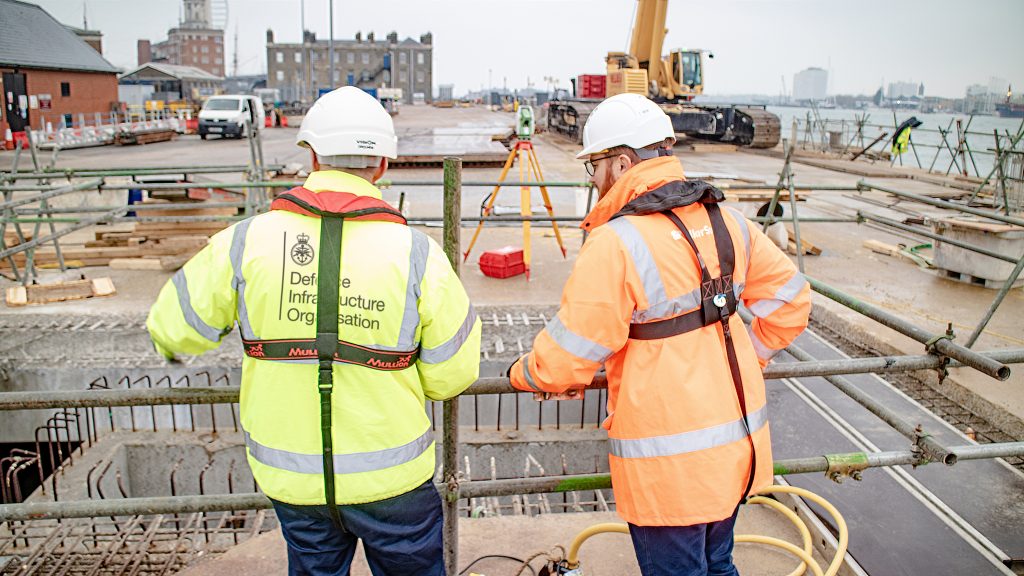
Portsmouth Naval Base is gearing up to become home to the HMS Prince of Wales, the second of the Royal Navy’s huge new Queen Elizabeth Class Aircraft Carriers.
HMS Queen Elizabeth and her sister ship, HMS Prince of Wales are the largest ships the Royal Navy has ever operated and will carry F-35(B) fighter jets.
HMS Prince of Wales is scheduled to arrive at her home berth in Portsmouth by the end of this year, and before then there is a lot of work to do to ensure the right infrastructure is in place to support her.
Getting Portsmouth ready
We are busy working with our contractors VolkerStevin on a £30 million project to ready the second operational berth at HMNB Portsmouth for the new aircraft carrier.

Regular readers of this blog will remember that we previously provided around £100m of new infrastructure to prepare for the arrival of the HMS Queen Elizabeth in August 2017. Back then the work concentrated on refurbishing the Princess Royal Jetty so that it was strong enough to take the strain of a fully-laden carrier. We also worked with Boskalis Ltd to dredge Portsmouth Harbour to ensure it was deep and wide enough for the huge vessels.
The work that we completed in 2017 put us good stead for this project and the bespoke equipment needed for the second berth is being modelled on what has already been provided for the first carrier, with a few adjustments based on experience from the first-time round!
A big part of this project is focused on making improvements to the existing Victory and Sheer jetties so they can support the 65,000 tonne new carrier.
Victory jetty was last refurbished 20 years ago and the work that we are doing now will extend its life for more than 50 years. Unlike the Princess Royal Jetty, Victory and Sheer jetties will continue to be used by other vessels as well as the carrier.
The work we are doing to strengthen Victory Jetty includes creating two new Fender Spacer Unit Hard Points and installing two additional Raker piles.
The Fender Spacer Units (FSU) will float between the ship and the jetty, the structures slot into the jetty and move up and down with the tide to prevent the ship’s overhanging flight deck from colliding with the jetty.
The FSUs are identical to those which were installed on the Princess Royal Jetty for HMS Queen Elizabeth. This time they are being constructed by local company ML (UK) Ltd, rather than being brought in from overseas, and are due to be put into position this summer. We are pleased to be able to support local industry through our supply chain.
We have also installed a Galvanic Cathodic Protection system (GACP) on all new and existing piles at Victory and Sheer jetties. The system has been applied to approximately 450 piles in total and will protect them from erosion.
The length of the carriers meant we needed to construct a new mooring dolphin at the southern end of Victory Jetty to secure HMS Prince of Wales. The dolphin measures approximately 12 metres by 6 metres and supports four bollards, each of which is capable of taking 150 tonnes of strain from the carrier.
You might remember the specialist High Voltage hydraulic boom that we delivered to support the first carrier. Through this package of work, we are providing a second boom that will link the carrier up to the new sub-station. The purpose-built boom is engineered to cope with the movements of the ship and the tide and ensure that the power supply to the ship is protected.
The boom will link into a second frequency converter which will convert the National Grid 50Hz to the vessel’s required 60Hz electricity supply.
This project is a real team effort and we have up to 90 workers on site at peak times, all working together to ensure that the project is completed in good time for the arrival of the HMS Prince of Wales. It’s a challenging but rewarding project and a once-in-a-lifetime career opportunity to deliver infrastructure for such a crucial Naval asset. We are proud to be playing our part to support future Naval capability.
Leave a comment